Picture Book Round-Up:
Five Illustrators Work Their Magic
(Plus JOHN BURNINGHAM, who is some kind of god)
 March 3rd, 2007 by jules
March 3rd, 2007 by jules
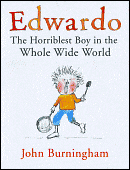
by John Burningham
Alfred A. Knopf
March 2007
My source: review copy
Let me admit right off the bat my heartfelt admiration for all things John Burningham. Big bias here. Love him. Can you tell from this post’s title? His works send me on an express train to Happy-ville. When I read that he had created a new book, I squealed — and would have done a few flips and somersaults were I a gymnast. The book is about Edwardo, “an ordinary boy,” as we’re told on page one. Sometimes he kicks things, is too loud, is nasty to other children, chases cats, leaves his room a mess, etc. But the adults in his life tell him — when he commits these customary childhood crimes — that he’s the ________est boy in the whole world. Fill in the blanks with roughest, noisiest, nastiest, cruelest, messiest . . . you get the picture. And, as a result, Edwardo becomes more and more cruel, nastier and nastier, noisier and noisier. This culminates mid-book with a friendly gathering of these adults — in a signature Burningham spread which I just wish I could show you — leaning over Edwardo, pointing hostilely, and exclaiming: “Edwardo, you really are THE HORRIBLEST BOY IN THE WHOLE WIDE WORLD.” Then things shift when Edwardo’s actions are interpreted as “good” by the adults around him. Edwardo is really not transformed in any way whatsoever, and he continues to sometimes be nasty to animals and still can’t quite clean his room. But when, for instance, he throws all his belongings out the window in lieu of actually cleaning his room and they all land in the truck bed of a vehicle collecting items for poor people, he is thanked for giving all his things away. “Look at Edwardo’s room. Why can’t you all be as neat and tidy as he is?” another adult says with a smile. So we have a cautionary tale here (what Publishers Weekly calls a “delightfully inverted” one) that pretty much sums up this (which lots of parents and teachers all over America have crocheted and hanging on their walls) in picture book form. It’s classic Burningham — with a straight and to-the-point style, no pretentious literary somersaults. And with his usual economically-rendered illustrations — borderless against ample white space — with playful, subtle humor and striking splashes of color. And Edwardo with his unruly, porcupine hair is unforgettable. As the reviewer in Kirkus Reviews put it, adult readers are going to get a lot out of this one; perhaps Burningham even directs it square in their faces. But that doesn’t mean it can’t be food-for-thought for children, too . . . If you’re a Burningham fan, in particular, this one won’t fail to please.
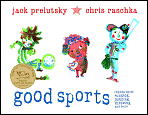
Running, Jumping, Throwing, and More
by Jack Prelutsky and illustrated by Chris Raschka
Alfred A. Knopf
March 2007
My source: review copy
I know Jack Prelutsky is our first ever ever ever children’s poet laureate, and that is a great thing. And I think he’s a talented poet whose contributions to the world of children’s literature are multifold. But the poetry in this, his latest creation, didn’t wow me. My response can be summed up thusly: Ho-hum. And I don’t like to spew forth negative energy on this blog, but 1> I didn’t flat-out loathe it, mind you, and 2> the illustrations are a joy . . . The book’s sub-title pretty much tells you what you’re getting: “Rhymes About Running, Jumping, Throwing, and More.” Prelutsky includes verses about baseball, soccer, distance-race running, basketball, playing Frisbee, ice skating, and much more. My favorite is the poem devoted to the poor swimmer who nevertheless loves moving in the water, the category in which I firmly place myself:
Though I like to swim,
I don’t swim very well.
I swim like a fish
That’s been sick for a spell.
I flop in the pool,
And I flounder around.
My friends laugh and say
I should stay on the ground . . .
The poems are about trying, failing, succeeding, trying again, aiming high in more ways than one, and much more. But, as Wendy from Blog from the Windowsill puts it so well in her recent Poetry Friday review of this title, “{w}ith almost every poem written in ABCB format (with two or three in AABB, for a smidgeon of variety) the voices of the poems lose any distinctiveness, making the book a sluggish read-aloud. (The absence of titles doesn’t help.) And there’s not much in the way of exciting imagery, thoughtful insights or even sharp rhyming to help the poems spring to life.” Word, Wendy. It lacks some ooomph. I think Raschka’s illustrations save it. Perfect choice for this subject matter. His swift watercolor and ink illustrations jump off the page with motion and direction and pedal-to-the-metal acceleration in whirls of energy and color and strong lines (case in point: the final illustration of the black belt in karate) . . . To end on a more positive note, I’ll add that the School Library Journal review points out that these poems “can also be used to introduce rhythm, rhyme scheme, punning, and alliteration.” I’ll accede to that, my friends. There are more inspired anthologies out there for such teaching moments, but Raschka will wow you with his expression and humor and bold brushstrokes.
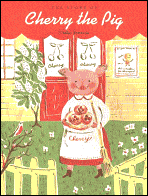
by Utako Yamada
Kane/Miller
Originally published in Japan, 2002; first American edition, March 2007
My source: review copy
Cherry the Pig is a baker. It’s her passion, and she excels at it. Having baked an apple cake one day and especially after having overheard a family of mice say with enthusiasm that it was “incredible,” she enters the concoction into the Harvest Festival bake-off. The “festive” is taken right out of said festival for Cherry when she hears the end of the mice family’s commentary on her baking: the cake is incredibly awful. (She hadn’t heard their complete opinion earlier, since she had run them off, away from what she thought was a delectable delight). Cherry is crestfallen, but lo and behold her apple cake is awarded first place (the coveted Golden Whisk) after all. Then comes her epiphany: she sees that the mice are eating hard, salty biscuits. To each his own, Cherry realizes, and in the end bakes the mice their own little biscuit treat after opening her own bakery. As for the art of this Japanese import, it’s a delight and a real throwback to 1950s/60s-era picture book illustrations with Yamada’s color choices (primarily, cherry reds, yellows, and greens) and in style as well (think Roger Duvoisin). Elzey at The Excelsior File nailed the charm of this book in his detailed review. I say that at the risk of sounding lazy, as if I do not want to give you any more commentary on this book; instead, I’m sending you to a spot-on review that pretty much says it all and which still sticks out in my mind after reading it a good while ago. As he points out, “{t}he book is deliberately paced in a way that is reminiscent of books several decades older yet still feels fresh.” Read and enjoy (especially if you want to read a bit more about Yamada, since Elzey was intrigued enough to find out more about this author/illustrator, who lives in Tokyo). And then treat yourself, so to speak, to this delicious title. Have a slice of apple cake as you read to really set the mood. Mmmmm, apple cake.
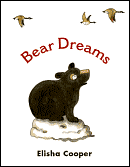
by Elisha Cooper
Greenwillow Books
August 2006
My source: library copy
Bear simply can’t sleep. He’s a bit miffed that the other animals get to play while he has to hibernate for the winter. It’s simply not fair, so he gathers together the other animals and tells them his plan. He wants to race, wrestle, climb trees, and fly across the lake. The animals inquire as to what to do if they get weary, and Bear forcefully says, “No!” to any such talk of rest. The animals scatter, and then suddenly Bear falls asleep . . . Cooper devotes sprawling spreads to simple sentences all throughout the book (“It’s not fair” and “Bear has an idea” and each expression of his wishes are granted entire double-page spreads). It’s a spare text, indeed, and with hushed, full-color art, graced here and there with serene pastels. The simple story will resonate with weary youngsters not wishing to succumb to sleep; they will also perhaps find comfort in the book’s closing spreads, in which Bear’s parents carry him to the cave where he sleeps through the winter, nestled in with his entire family. An inviting tale to add to the bed-time collection.
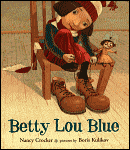
by Nancy Crocker and illustrated by Boris Kulikov
Dial Books for Young Readers
October 2006
My source: library copy
“Betty Lou Blue had the world’s biggest feet. Whackety, thwackety, flappety feet.” You can add that to your Memorable Opening Lines of Literature list. This story, Nancy Crocker’s picture book debut, is one to be read before your winter — in whatever part of the world you live in — ends. Betty Lou Blue gets mercilessly teased for those honkin’ big feet. Her mother tries to reassure her: “Betty Lou, why, everyone’s perfect, dear — yes, even you! There’s no one just like you — you’re special, you see. And each living thing has a reason to be.” Then, one day a huge winter storm arrives, and school is let out early. While all the other kids play and romp through the snow, Betty Lou Blue (a.k.a. “Footy Lou Freak!”) watches from a distance. When a little avalance of snow falls on the children, only a big-footed hero can save the day. The catch is that Betty must decide whether to seize the opportunity to “pay them all back. And all it would take was her walking away . . .” But — and you know it’s comin’ — “Betty Lou knew what her mama would say. ‘Dear, everything’s ugly/ that’s done out of spite/ But you can be beautiful doing what’s right.'” It’s a sweet, tidy, moralistic tale with a lot of heart, and young children are drawn like magnets to tales of bullies. And Kulikov’s art is always a wonder to behold, what with his rich, bold colors, big-eyed characters, playful perspectives, and lavish detail. And his imaginative touches are nothing to sneeze at: When the other kids yell at Betty that she could fly if her feet were wings or she could float for a year if her shoes were boats, Kulikov goes to town with the metaphors in the book’s first gorgeous double-page spread . . . Once upon a time, Kelly at Big A, little a reviewed this one for a Poetry Friday entry, as it’s written in verse. Snag this warm winter-time read before the first daffodils bloom.

How fab. I didn’t know John Burningham or Elisha Cooper had new books out. Thanks, J!
Jules, I think Edwardo is a must-have. Thank you! Did you guys review “17 Things I’m Not Allowed to Do Any More”? I will check your archives. So funny, and yet…so familiar!